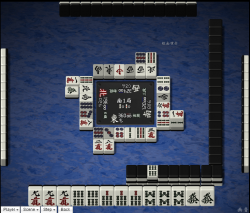Furiten

Furiten, meaning sacred discard, is a hand status. A player in tenpai is furiten if he could win on an earlier self-discarded tile, or if he has recently ignored to win by ron. Players in furiten may still win by tsumo, but not by ron.
Rules
A player with a tenpai hand is furiten, as indicated by the discard pile. Basically furiten subjects a player under these two conditions:
- Players in furiten may not win by ron, even if they have a yaku. Declaring ron while in furiten is penalized with a chombo payment.
- Players in furiten may still win by tsumo.
The furiten rule does not consider yaku. Sometimes, a hand can be completed with several tiles, but only some of them provide a yaku, others would produce a yakuless hand. If a yakuless tile appears, it must be ignored, because a winning hand must contain a yaku. The player must remain temporarily furiten.
Furiten in general
A player is furiten, if a winning tile is present in one own's discard pile. It does not matter whether this tile would have provided a yaku or not. Tiles turned sideways within open melds are considered part of their discarder's discard pile.
As long as the player has not declared riichi, furiten can be avoided by altering the hand and changing tile waits.
This hand has three different tiles to wait on. If the player has a 2-pin in his own discard pile, he is furiten and may not win by ron on any tile. Even if a 5-pin or 8-pin gets discarded by an opponent, he may not call ron.
Furiten during riichi
After declaring riichi, the discarded tile immediately after the declaration is turned sideways. The purpose is to indicate, when the player had declared riichi. By rule of riichi, a player is simply waiting for winning tiles after that point. Any tiles discarded after the riichi declaration are deemed as safe tiles.
So, a riichi declarer is furiten when a chance to call ron has been declined. The ignored winning tile may have been a discarded tile or a tile used to extend a minkou to a shominkan. The player will remain furiten for the rest of the hand and thus cannot call ron on any tile. Furiten applies even, if it is a different tile than the ignored one. This rule requires knowledge of all own possible waits.
In a sense, this disallows a riichi declarer to be deceptive with regards to winning tiles. The player could decline ron from one player and expect to declare ron against another player, off of the same time. Of course, this is against the rule. So, naturally, during furiten, a declared riichi disallows that style of player. However, this tactic is acceptable via damaten or with an open tenpai hand.
Turn based furiten
A player may be in furiten temporarily, when a player has a tenpai hand, without riichi, declined to call ron. Upon doing so, the player is then temporarily furiten until the next draw-discard process. After making the discard, the player is no longer in furiten. Some rules additionally cancel temporary furiten on any tile call by any player.
Strategy
The furiten rule may be applied for defensive play, which focuses on discarding safe tiles. By discarding tiles that are also visible in an opponent's discard pile, a player can avoid a ron call by that opponent. Likewise, usage of suji and kabe may also help players deduce safe tiles, based on opponent discard. This is applied when a player does not have any matching tiles in the hand with opponent discard; or a player may rather keep certain tiles, for the sake of developing the hand without tearing it apart.
Dealing with furiten
Sometimes, it may be necessary to deliberately place the hand in furiten. Often times, this is the result of developing the hand and defending simultaneously.